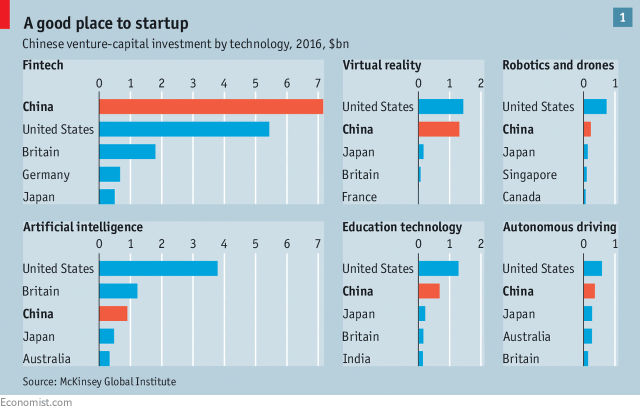Three Critical Technologies China Is Taking The Lead In

China’s concerning approach to technology
A ‘Unicorn’ is a technology start-up company worth more than $1bn. Wikipedia maintains a list of the most successful ‘Unicorns’ in the world, numbered by valuation. On it, the US has 16 entries, China has 26, Europe has 0 and the rest of the world shares those that remain.
The number of successful new tech companies the country produces is just one example of their burgeoning leadership in technology. China is streaking ahead the rest of the world in a number of quiet but important ways, including the quantity of research papers published on technology matters, the number of students trained in STEM (Science, Technology, Engineering and Maths) as well as simple dollar based metrics like the amount of Venture Capital money invested in technology start-ups. (As ‘The Economist’ makes clear – see chart, below.)
China has a natural set of advantages, which positively differentiate it from the countries it competes with, but none is more significant than the involvement of its government. The ruling Communist Party has a clearly stated desire to lead in many of the cutting edge technology of our time, takes a longer term view than that undertaken by rivals and a unique flavour of mixed economy, in which they insert a member of their ruling party, on the board of any tech company deemed big enough make sure that it does not stray too far from the National Interest.
The US, on the other hand, typically a leader in the field of technology ‘has’ to leave the solution of this sort of investment issue to the market, to resolve. Western technology companies are mostly floated on the US Stock Market and, as a result, have a responsibility to deliver short term benefits to shareholders, wherever possible.
It seems the technology landscape we know, in which every Internet connected mobile phone and laptop in the world orbits Cupertino is changing. At stake are huge economic benefits and, potentially, a material shift in the culture of most of the world.
Here are 3 technologies in which China has taken a clear lead.
China has established a ‘Mega Project’ around Quantum computing
One good example demonstrating the kind of seriousness with which China is approaching its technology investment in the future is Quantum Computing.
Quantum computers exploit a feature of subatomic particles known as ‘super position’. By lining up many of these quantum elements, which act as both a ‘0’ and a ‘1’, the resulting computer can perform enormous numbers of calculations in the blink of an eye.
Quantum computers have applications in code breaking, simulations in chemistry and resolving problems with a large number of potential outcomes.
The technology still has some way to go and a number of fundamental problems lining Qbits (the Quantum Bits which are the core of the solution) reliably. Nevertheless, China has established a ‘mega-project’ around the possibilities present in Quantum Computing.
China publicly sates strategy of owning the Artificial Intelligence market
The market for Artificial Intelligence (AI) services is going to be worth $300 billion by 2030, according to the Chinese government. China already has incredible AI capabilities. Police are equipped with AI fuelled facial recognition glasses which they use in locations where there is a lot of foot traffic – such as railway stations to oversee the public and arrest miscreants.
Alibaba, China’s biggest technology company now runs an entire city, directing traffic through it using AI. (They’ve improved flow 15%) Jack Ma, who started the Alibaba company in 1999 has allocated $15 billion over 3 years into a research institute which will focus, largely on AI projects. The facility is called DAMO – Discovery, Adventure, Momentum, and Outlook. The investment will push them to the top of the global pile for R&D spending, above the amounts spent by Apple and Facebook, the current world leaders, both headquartered in the US.
Exaflop computing
Exaflop computers are those capable of conducting one billion calculations per second that’s 5 times faster than the current world maximum. Supercomputers like this are enablers for progress in other fields of R&D, like simulations, AI research, genomic modeling, and weather pattern replication.
China has (again) publicly stated their desire to build the first in the world to deliver an Exaflop computer, going head to head against competitive projects in Europe, Japan, and the US. Their goal is to deliver one by 2020. The closest competitor, America believe they can deliver one only 2 years later.
So What? What happens if China wins the technology race?
The primary goal of China’s technology investments are likely to be the economic benefits associated with being first to market, which, in technology terms often equates to owning it. The financial ramifications, for China, and its citizens are, of course, part of a broader trend of power moving to China, politically, militarily and socially.
The truth is we just don’t know what will happen if they win in these and other arenas. It’s possible the effects will be similar in magnitude to the Americanisation of Western culture that has taken place in the 20th Century, under which Hollywood made the films we watch, Coke made the drinks we consumed and the US Military invaded the countries they felt had strayed too far from American values.






